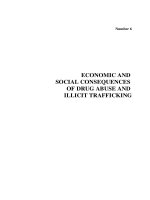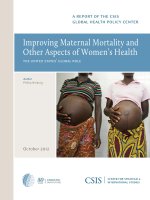Aberrance, agency and social constructions of women offenders
Bạn đang xem bản rút gọn của tài liệu. Xem và tải ngay bản đầy đủ của tài liệu tại đây (4.24 MB, 259 trang )
Aberrance, Agency and Social Constructions of
Women Offenders
A Thesis submitted in fulfilment of the requirements for the
Degree of Doctor of Philosophy
by
Carol Quadrelli
BA (Hons) Griffith University,
GradDipEd, Queensland University of Technology
School of Justice Studies
Faculty of Law
Queensland University of Technology
2003
Key Words
Aberrance; agency; essentialism; resistance; criminal justice system; female
offenders; women’s prisons; women’s experiences of the criminal justice
system.
i
Abstract
Traditionally offending women are framed through essentialist discourses
of pathologisation and the family. Hence, good women are constructed as
passive, compliant, vulnerable to victimisation, and nurturers. Offending
women are constructed within criminal justice processes as disordered,
physiologically and psychologically flawed. Censure or sympathy
dispensed to women within the system is contingent on a number of key
factors: the type of offence, the category of women involved, and the way in
which women interact and negotiate the discourses used to construct their
aberrance.
The focus of this thesis is offending women and how they are socially
constructed through legal and penal discourses within the court and the
prison. However this thesis rejects the essentialist framework which
positions women as passive recipients of an omnipotent patriarchal
criminal justice system and thus having no agency. Nor is this thesis about
creating a new entity to encompass all offending women. Instead an antiessentialist approach is adopted that allows the body, power, and women’s
agency to be theorised. This approach provides a more complex and
detailed account of women’s aberrance that acknowledges the diverse
range of women, their experiences and negotiations of criminal justice
processes. The combination of real women’s lived experiences and an
alternative theoretical framework provides a very different perspective in
which to understand female offending.
ii
Table of Contents
KEY WORDS ........................................................................................................................i
ABSTRACT............................................................................................................................. ii
TABLE OF CONTENTS ...................................................................................................... iii
LIST OF APPENDICES ....................................................................................................... vi
LIST OF TABLES ................................................................................................................. vii
LIST OF FIGURES ............................................................................................................ viii
LIST OF ABBREVIATIONS ............................................................................................... ix
DOCUMENT SOURCES .................................................................................................. IX
OTHER ABBREVIATIONS .............................................................................................. IX
GLOSSARY OF TERMS........................................................................................................x
STATEMENT OF ORIGINAL AUTHORSHIP ............................................................. xii
ACKNOWLEDGMENTS .................................................................................................. xiii
CHAPTER ONE - RAISON D’ÊTRE.................................................................................1
1.1 INTRODUCTION........................................................................................................1
1.2 RESEARCH FOCUS ...................................................................................................5
1.3 SIGNIFICANCE OF THE STUDY ..................................................................................6
1.4 THEORY ................................................................................................................10
1.5 METHOD ...............................................................................................................12
1.6 THESIS STRUCTURE ...............................................................................................14
1.7 CONCLUSION .........................................................................................................16
CHAPTER TWO - ESSENTIALIST VISIONS OF ABERRANT WOMEN..............18
2.1 INTRODUCTION......................................................................................................18
2.2 ESSENTIALISM .......................................................................................................19
2.3 THE MASCULINITY HYPOTHESIS ............................................................................21
Medical discourse and pathologisation .......................................................22
Sexuality .......................................................................................................24
2.4 THE CHIVALRY HYPOTHESIS ..................................................................................24
Arrest phase .................................................................................................26
Sentencing outcomes ....................................................................................27
2.5 THE LIBERATION HYPOTHESIS ...............................................................................29
2.6 FEMINIST FRAMES: FAMILIAL/PATHOLOGICAL/SEXUALITY ..................................30
Married women and good mothers ..............................................................33
2.7 ESSENTIALISM AND PRISON LITERATURE ...............................................................35
2.8 ENVISIONING THE FEMALE OFFENDER ...................................................................38
Revisioning women’s aberrance ..................................................................41
Future Directions for Feminist Research ....................................................42
2.9 CONCLUSION .........................................................................................................44
CHAPTER THREE - THEORISING NETWORKS OF POWER, SPACE, THE BODY
AND RESISTANCES ..........................................................................................................47
3.1 INTRODUCTION .....................................................................................................47
3.2 KNOWLEDGE, POWER AND DISCOURSES OF THE LAW, FEMININITY, SEXUALITY AND THE
BODY........................................................................................................................... 49
3.3 FEMINISTS ON DISCOURSES AND THE BODY ...........................................................51
iii
Bodily inscriptions .......................................................................................56
3.4 COMPLIANCE AND RESISTANCE .............................................................................59
The female body as a site of resistance ........................................................61
Space, power, resistance and compliance....................................................63
The habitus of the court and prison .............................................................65
3.5 CONCLUSION .........................................................................................................69
CHAPTER FOUR - RESEARCH DESIGN AND METHODOLOGY .......................71
4.1 INTRODUCTION......................................................................................................71
4.2 RESEARCH RATIONALE ..........................................................................................78
4.3 FEMINIST ETHNOGRAPHY ......................................................................................74
Strengths and weaknesses ............................................................................75
Problems in prison ethnography ..................................................................78
4.4 RESEARCH PROCESS ..............................................................................................83
Data collection .............................................................................................83
Observational records .................................................................................84
Court observations .......................................................................................84
Prison observations .....................................................................................85
Journal entries .............................................................................................86
Court transcripts ..........................................................................................86
Other stakeholders .......................................................................................86
Use of vignettes and case studies .................................................................87
Informed consent..........................................................................................87
4.5 TRUST AND CONFIDENTIALITY ..............................................................................88
4.6 THE INTERVIEW PROCESS ......................................................................................90
Timing and location of interviews ................................................................93
4.7 MANAGEMENT, VALIDITY, AND INTERPRETATION OF DATA ..................................96
Validity of data.............................................................................................96
Interpretation: constructing the ethnographic account ...............................98
4.8 CONCLUSION .........................................................................................................99
CHAPTER FIVE - INCREDIBLE WOMEN NEGOTIATING LEGAL DISCOURSES OF
FEMININE DISORDER .................................................................................................... 101
5.1 INTRODUCTION.................................................................................................... 101
5.2 NEGOTIATING THE COURT AS A SITE OF INSTITUTIONAL POWER .......................... 103
Performances and discourses .................................................................... 107
Negotiating feminine discourse .................................................................. 108
Negotiating familial discourse: the good mother ....................................... 113
Negotiating pathologisation....................................................................... 116
5.3 FEMALE VOICES AND LEGAL REPRESENTATION ................................................... 118
Inexperience with criminal justice system.................................................. 123
Experience with criminal justice system .................................................... 124
5.4 THE GOOD (BUT VICTIMISED) DAUGHTER ............................................................ 126
5.5 THE OFFENDING WOMAN NEGOTIATING SELF DEFENCE ....................................... 130
5.6 CONCLUSION ....................................................................................................... 133
CHAPTER SIX - NEGOTIATING TIME IN THE BIG HOUSE .............................. 134
6.1 INTRODUCTION.................................................................................................... 134
6.2 HABITUS OF A WOMEN’S PRISON ........................................................................ 135
Punishment and control ............................................................................. 139
6.3 SOCIAL CONSTRUCTIONS OF FEMALE INMATES.................................................... 140
6.4 AGENCY, RESISTANCE AND COMPLIANCE ............................................................ 146
Scoring on the inside – illegal drug use ..................................................... 155
Legal medication of women inmates .......................................................... 157
6.5 NEGOTIATING SERVICES WITHIN THE PRISON: PROGRAMS ................................... 159
Drug programs .......................................................................................... 167
Work........................................................................................................... 170
6.6 NEGOTIATING HEALTH SERVICES WITHIN BWCC ............................................... 171
Post release ................................................................................................ 175
iv
6.7 CONCLUSION ....................................................................................................... 176
CHAPTER SEVEN - CONCLUSION- ......................................................................... 178
7.1 INTRODUCTION.................................................................................................... 178
7.2 SIGNIFICANCE OF THESIS ..................................................................................... 177
7.3 IMPLICATIONS OF RESEARCH ............................................................................... 184
Further research ........................................................................................ 189
7.4 LIMITATIONS OF THESIS ...................................................................................... 190
7.5 CONCLUSION ....................................................................................................... 191
BIBLIOGRAPHY ........................................................................................................ 218
v
List of Appendices
APPENDICES......................................................................................................................192
APPENDIX 4.1 ETHICAL CLEARANCES ....................................................................... 193
APPENDIX 4.2 PROFILE OF RESEARCH SITES ............................................................. 198
Brisbane Magistrate Courts ....................................................................... 198
Brisbane District Court.............................................................................. 198
Brisbane Supreme Court ............................................................................ 199
Correctional facilities for women in Queensland ...................................... 199
Brisbane Women’s Correctional Centre .................................................... 199
Crisis Support Unit (CSU) ......................................................................... 200
APPENDIX 4.3 SAMPLE OF COURT LISTS ................................................................... 201
APPENDIX 4.4 COURT ATTENDANCE AT BRISBANE MAGISTRATES COURTS 1 & 2 ....203
APPENDIX 4.5 LETTERS TO INMATES ......................................................................... 204
APPENDIX 4.6 FIRST INTERVIEW FORMAT ................................................................. 210
APPENDIX 4.7 FOLLOW UP INTERVIEW FORMAT ........................................................ 211
APPENDIX 5.1 MEDIA COVERAGE OF JOY ANN LANE’S CASE .................................... 212
APPENDIX 6.1 BWCC PROGRAMS 1997.................................................................... 216
APPENDIX 6.2 INMATES AND INTERVIEWEES BY MOST SERIOUS OFFENCE.................217
vi
List of Tables
Table 1.1 Prison population growth rate 1994-99 ..................................................... 3
Table 1.2 Indigenous rates of incarceration nationally .............................................. 4
Table 4.1 Offending profile of BWCC inmates and interviewees by most serious offence
................................................................................................................................. 90
Table 6.1 Female prisoners by known prior adult imprisonment in Queensland as at 30
June 1998 ................................................................................................................145
Table 6.2 Female Escapes and absconds from secure, open and community custody
environments ..........................................................................................................153
Table 6.3 Mental Health indicators-female and male prisoners BWCC and AGCC, October
1999 ........................................................................................................................172
vii
List of Figures
Figure 1.1 Actual and forecast number of the female prison population in Queensland 1988
–2011............................................................................3
viii
List of Abbreviations
Document sources
CL
Court list
CT
Court transcripts
DE
Diary entries
IN
Interview notes
TS
Tape transcripts
Other abbreviations
ABS
Australian Bureau of Statistics
AIC
Australian Institute of Criminology
ALRC
Australian Law Reform Commission
BWCC
Brisbane Women’s Correctional Centre
BWS
Battered Woman Syndrome
CSU
Crisis Support Unit
DPP
Department of Public Prosecution
DU
detention unit
DV
domestic violence
FTA
fail to appear
IDU
intravenous drug use
NWCC
Numinbah Women’s Correctional Centre
QLD
Queensland
QCORR
Queensland Corrections
QCSC
Queensland Corrective Services Commission
TWCC
Townsville Women’s Correctional Centre
ix
Glossary of Terms
aberration
a departure from what is normal or accepted as right; a moral
or mental lapse
aetiology
a term with several related meanings: the assignment of a
cause or reason, the philosophy of causation, the science of
the causes of disease.
agency
agency is located within the body of the female offender as
she negotiates specific criminal justice processes. Resistance
and compliance are outcomes of agency and are
demonstrated by stylised performances of the self.
breach
a disciplinary procedure where inmates are punished for
breaking rules
co-ey
dogging
co- accused
when one offender gives information concerning another
offender to authorities
‘done
methadone
dropping
drug overdose
essentialism Essentialism has several interpretations: first, the belief that
things have a set of characteristics which make them what
they are; second, that the task of science and philosophy is
their discovery and expression; and third, essentialism is the
doctrine that essence is prior to existence.
lockdown
during lockdown inmates are confined to their cells for a
period of time. A lockdown can occur for a number of
reasons.
Mirikai
a drug rehabilitation centre located in Brisbane
‘out
shopping’
shoplifting
screws
prison officers
‘the girls’
term used by both prison staff and by women inmates
x
thirdspace
represents the space beyond dualisms ie public/private,
male/female. Term used by social scientists, cultural critics
and geographers.
UT
urinalysis testing
‘working
girl’
sex-worker
xi
Statement of Original Authorship
The work contained in this thesis has not been previously submitted for a
degree or diploma at any other higher education institution. To the best of
my knowledge and belief, the thesis contains no material previously
published or written by another person except where due reference is
made.
C. Quadrelli
Signed:_____________________
Date: _____________________
xii
Acknowledgments
This thesis would not have been possible without the support and
cooperation of Queensland Corrective Services Commission and the inmates
and staff of the Brisbane Women’s Correctional Centre. I would like to
extend my sincere appreciation to all those concerned. In particular, I am
indebted to the inmates who gave so generously of their time candidly
sharing their experiences. Without their support, this thesis would not be the
document that it is. Your humour, spirit and resilience are inspirational.
I am also grateful for the Queensland University of Technology APA
Scholarship that enabled me to undertake this incredible research journey.
The Scholarship provided me with the time and opportunity to develop an
approach that captures the real accounts of women’s experiences of criminal
justice processes. I thank the School of Justice Studies for its support over the
years and my Principal Supervisor, Dr Belinda Carpenter and Associate
Professor Simon Petrie. Your input and guidance have been invaluable. The
journey has been challenging on so many levels and yet so satisfying. Thank
you for being a part of it.
Over the years, I have been most fortunate to have the support and
friendship of QUT colleagues who have provided me with inspiration and
the motivation to ‘keep going’. Many thanks to Associate Professor Sue
Grieshaber, Sue Currie, and Dr Christine Eastwood.
This thesis has had a huge impact on my family and friends. Thank you for
your understanding, patience and support. In particular, I express my love
and gratitude to my partner Philip and son Nick. True to form, I commenced
this journey, organised the itinerary and you both carried the bags. Words
cannot express the immense gratitude I feel for your unconditional support,
xiii
humour, encouragement and unwavering belief that I had the ability and
the right maps to complete this journey.
xiv
CHAPTER ONE
Raison d’être
1.1
Introduction
Women and crime is a fascinating topic within contemporary Western
culture, with criminal women constructed as titillating, incredible and
horrifying. More specifically, deviant actions by women - particularly
violent offences - are fascinating in ways that men’s violence is not
(Braidotti, 1997; Naylor, 1993). This is because offending women are
constructed as displaying signs of abnormality and of difference. This
difference represents a mark of inferiority and within woman such a sign of
difference is monstrous (Braidotti, 1997). Moreover, crime has been, and
continues to be, constructed by and within a male domain. That is, the
significant players are predominantly male - from the lawmakers to the
judiciary, the criminal to the correctional officer.
The purpose of this chapter is to provide a general overview of offending
patterns and the impetus for undertaking this research project with a focus
on offending women’s negotiations of criminal justice processes. A brief
discussion of the significance, theory and method adopted follows. The
chapter concludes with the organisation of thesis chapters.
Statistically, the majority of offenders are male and their behaviour
perceived as natural masculine aggression. To conflate masculinity with
deviant behaviour creates a benchmark, normalising and naturalising men’s
actions. By contrast, women are perceived as passive and compliant, and
portrayed as victims of circumstance. Any deviant behaviour is thus
attributed to either physiological dysfunction or circumstances beyond her
control. Women’s deviant actions are then reframed as an aberration (Mills,
1
1997).
Current discourses on women and the law focus on women’s social and
economic position within society – with aberrant actions explained through
women’s victim status (Shaw, 1995). Other research identifies young
women’s actions are deemed as irrational and symptomatic of individual
pathology rather than of conscious rebellion and resistance (see also Allen,
1987a; Henning, 1995; Hudson, 1990; Maher, 1997).
However the question is more complex than whether or not aberrant
women are victims of life circumstances and/or the patriarchal mechanism
of the criminal justice process. Certainly many of the women interviewed
for this research project would not locate themselves as victims. They
acknowledge their agency and demonstrate this in a range of ways whilst
negotiating criminal justice sites. This thesis seeks to address how some
women offenders actively engage with, either through compliance and/or
resistance, discourses used to explain and manage their aberrance.
Just as women’s level of representation as criminal justice professionals is
slowly increasing, so too the level of women incarcerated is increasing albeit at a more vigorous rate. For the purpose of this thesis the central
focus is on women as offenders, the discourses used to construct them
within the criminal justice domain and how such constructs are negotiated.
A range of factors provide the impetus for the focus and framework of this
thesis, Aberrance, Agency and Social Constructions of Women Offenders.
First, the past decade has witnessed a rapid acceleration in the rates of
women offenders (juvenile and adult) entering the criminal justice system.
This increase is reflected both at national and international levels. Future
projections indicate a continual increase (See Figure 1.1).
2
Figure 1.1 Actual and forecast number of the female prison population in Queensland 1988 – 2011
Source: Queensland Corrective Services Commission Profile of Female Offenders 2000
More specifically, Queensland’s incarceration rate has experienced an influx
never previously witnessed (See Table 1.1), especially amongst young
Indigenous women (See Table 1.2), exceeding the growth in imprisonment
rates of Indigenous and non-Indigenous men. Surveying the overall picture
of prison trends, this ever-increasing population of offending females
represents a statistical minority, an insignificant number when compared to
the total prison population and the wider community. As such this group
remains a blurry figure, their realities interpreted as one, within an
essentialist framework underpinned by fixed dualisms of masculine and
feminine. Such a framework inhibits any meaningful understanding of
women’s experiences, excluding any construction of ‘woman as agent’ in
negotiating criminal justice processes. However only a minority of research
rejects
the
essentialist
underpinnings
of
traditional
feminist
and
criminological theories (Carrington, 1993; Carrington, 1998; Daly & Maher,
1998; Maher, 1997). In the main, new ways of thinking about women and
offending continue to be framed within essentialist boundaries.
Table 1.1 Prison population growth rate 1994-99
1994
1999
Growth Rate
(%)
MALE
FEMALE
TOTAL
2391
4456
86.36%
100
273
173%
2491
4729
89.84%
Source: Queensland Corrective Services Commission Profile of Female Offenders 2000
3
Table 1.2 Indigenous rates of incarceration nationally
Aboriginal & Torres Strait Islanders
Rate per 100 000 Population
in custody nationally
of Imprisonable Age
1983
1985
1987
1989
1991
1993
1983
1993
% Change
Male
1070
1100
1688
1714
2045
2287
1719
2749
59.9
Female
48
53
78
111
121
129
77
152
97.4
Total
1118
1153
1766
1825
2166
2416
869
1438
65.5
Source: AIC website
Second, mainstream criminological discourses on crime and offending (both
historically and traditionally) have framed such activity as an essentially
masculine trait, fervently interpreting and managing data within a
masculine framework. Criminal justice institutions such as judicial courts
and prisons further articulate these values in their architecture, discourses
and modus operandi. As will be explored more fully in the following
chapters, such factors have a subtle impact upon an individual’s experiences
of, and engagement with, such processes.
Both the courtroom and the prison are examples of institutional sites where
specialist knowledges and meanings, and specific discourses, are deemed
acceptable. As with legal discourses, penal policy for women continues to be
framed through an essentialist framework deploying gender specific
assumptions about women’s role in society and the behaviour and needs of
women in prison.
A third impetus for this thesis is the social and legal constructions of
aberrant women. Traditionally, the criminal justice system’s response to
aberrance tends to be that men are bad and normal and treated within the
legal/punishment paradigm while women are mad and abnormal and in
need of the welfare/treatment model (Frigon, 1995; Wilczynski, 1995). The
criminal woman is a fallen woman and past and present discourses of
offending women replicate such representations (Dobash, Dobash, & Noaks,
4
1995; Naffine, 1987, 1995, 1997; Scutt, 1997a, 1997b). For example, the
archetypal image of Eve represents impregnated womanhood, its fallen
condition characterised by inherent weakness, susceptibility to temptation
and a propensity for sensuality (Hirschon, 1993). Whether ‘woman’ is the
accused person, sentenced offender, victim, or a witness, she is nonetheless
regarded as ‘incredible’. That is, woman is not to be believed and is
susceptible to questioning about her sexuality, her sexual presence, and her
character as a woman (Scutt, 1997a, p. 138).
1.2
Research Focus
Initially, this project was undertaken to address the demand for research to
ascertain just how gender is operating in women’s treatment by, and
engagement with the justice processes and in sentencing outcomes (Alder,
1994a; Australia Law Reform Commission, 1994a; Howe, 1994; Naylor, 1993;
Zdenkowski, 1994). My overall objective was to explore the ways in which
different categories of women are perceived or constructed within the justice
system processes and the systems subsequent treatment of such categories of
women.
However, as the research gathered momentum, a micro level of dynamics
emerged. The research method is thus derived from a tiered system of
interlinking objectives. At a macro level my objectives are twofold: first to
consider the extent, type and complexity of women’s crime within
Queensland; second to explore the gendered characteristics of criminal
justice procedures through a continuum of acceptable and unacceptable
narratives of female deviance. More specifically, this thesis attempts to
ascertain how acceptable and unacceptable discourses of female aberrance
are constructed and negotiated by women offenders at the criminal justice
sites of the courts and the prison.
5
Through an exploration of these objectives, a concise picture emerges of
how different categories of women are perceived and constructed within
judicial and legal discourses, highlighting women’s agency in their
negotiation of such discourses. Yet another important objective of this thesis
is to document and validate the very real, and differing experiences of
women encountering Queensland’s criminal justice system. At a micro-level,
a core objective of this thesis is to explore the degree to which women
display agency and resistance in negotiating a range of discourses (i.e. legal,
medical, pathologising) in the court and the prison.
1.3
Significance of the Study
There are four significant aspects of this research. First, a range of
criminological discourses have developed over the last century to explain
and manage the offending behaviour of aberrant female individuals. The
theories underpinning the majority of these mainstream discourses tend to
be essentialist, perhaps with modifications and a shift in focus over the
decades. At a theoretical level, this thesis contributes to the field of feminist
criminology by providing a critique of previous accounts of female
offending as well as disrupting essentialist accounts of female offending.
Links between gender, crime and victimisation occurred in the 1970s when
feminist scholars focussed on women as victims and criminals. A large
proportion of this research centred on the victimisation of women,
specifically male violence against women. During the 1970s and 1980s many
feminists worked in various ways to politicise men’s violence against
women (Carrington, 1998; Dobash et al., 1995; Howe, 1994; Mills, 1997). This
thesis acknowledges that as a minority group, categories of women are
disadvantaged by our criminal justice system. Nonetheless it aims to reject
and disrupt the notion of woman as victim and explores the more nuanced
elements of women’s agency and resistance to the discourses that construct
6
them within the court and penal systems.
Second, literature on women and crime in Australia has been established
slowly over the past twenty years. Of particular concern is the lack of
qualitative research available on women offenders’ experiences of judicial
and penal processes. Opportunities to research women’s imprisonment are
limited and constrained by changing culture, resources of universities,
funding bodies, power and policies of governments and public institutions.
Research focussing on women’s correctional facilities has become a sensitive
and politically volatile issue (see also Cook & Davies, 1999; Grimwade, 1999,
p. 303). At present there is limited Australian research on women’s
experiences of criminal justice processes, particularly at the court and the
incarceration phases. This is a gap this thesis seeks to address. Increasing
incarceration rates combined with high rates of recidivism make this
research pertinent by providing data on what it is to be female and negotiate
criminal justice processes.
Third, reports and other research also indicate that there is a lack of research
on women, crime and sentencing within Australia. Recent research suggests
that gender still affects decision making in complex ways which also
indicates a need for more research into sentencing patterns (Alder, 1994a;
Australia Law Reform Commission, 1994b; Dobash et al., 1995; Hampton,
1993; Howe, 1994; Naylor, 1993).
Fourth, the majority of research conducted tends to adopt an essentialist
perspective and as a consequence women are framed as victims. This thesis
builds upon a small but growing cluster of works that acknowledges
offending women’s agency and resistance. In contrast to the majority of
research undertaken, research utilising a feminist framework to understand
women and their modes of resilience, coping, and resistance is in the
minority. This framework is capable of exploring ways in which racial, class
7
and gender inequalities constrain women’s lives as well as documenting the
ways in which women deal with their circumstances, how they endure and
transcend the difficulties, creating inventive strategies for removing and/or
circumnavigating the reality of their lives (Daly & Maher, 1998; Franz &
Stewart, 1994; Maher, 1997). Maher & Daly (1998) refer to this perspective as
intersectionality whereby these aspects are acknowledged as central to good
research.
Moreover, feminist theories that do rely on essentialist parameters in
framing women’s aberrations tend to elicit a pathological response,
especially with regard to violence by women (Allen, 1987b; Bradfield, 1998;
Shaw, 1995). This is because women as perpetrators of violence challenge
notions of femininity. Aberrance and violent behaviour tends to be
conceptualised in masculine and simplistic terms. It is problematic however,
to see women’s violence from the perspective of violent acts by men (Mills,
1997; Shaw, 1995). This thesis thus explores the relationship between gender,
victimisation, aberrance, and female offending.
Several Australian studies have noted the importance of individual
differences between magistrates, with a number of studies identifying clear
gender-stereotypes in sentencing when the category of ‘woman offender’ has
been explored (Naylor, 1993). Some researchers have observed that women
may be treated more leniently than men when they act in an acceptable
feminine role, but that they seem to receive no advantage, and may in fact be
treated more severely, if engaging in ‘unfeminine’ crimes (i.e. crimes of
violence) or in untraditional roles (Naylor, 1993; Wilczynski, 1995; Worrall,
1990). Moreover, women’s credibility and aberrance is constructed within a
range of pathological discourses at various criminal justice sites. Naylor
(1995) identifies six archetypes that are deployed to explain women’s
aberrance and all fall within an essentialist framework. These include:
8
Madonna/whore; sexual passion/love; reproduction and madness; the evil
monster/witch; the criminal woman as not-woman; and the female as
devious and manipulative (Frigon, 1995; Naylor, 1993; Scutt, 1993). Recent
research has utilised frameworks of sexuality, madness, domesticity, social
control of family/ economic dependency, as modes of subjectivity
(Bosworth, 1999; Worrall, 1987, 1990) and most recently mad/sad/bad
categories (Easteal, 2001). To varying degrees, this body of research
acknowledges the essentialising of the female offender through pathological
and familial discourses yet they remain locked into this very framework in
their own analysis.
This is because the question not addressed is that of women’s agency,
specifically their resistance and negotiation of the discourses used to
construct aberrance that in turn underpin the mechanisms of criminal justice
processes. There are many forms of resistance (see Faith, 1994; Foucault,
1980; Grosz, 1990; Grosz, 1994) and this thesis attempts to demonstrate how
women can be resisting while complying in a particular setting (such as
prison and the courtroom). Mills (1997) defines resistance as ‘a flight from
the body’ that ‘may be enacted in various ways: religious or transcendental
belief systems; or attempts to change the body in which one is trapped’
(Mills, 1997, p. 204). One such example is the inmate who attends programs
for the sole purpose of ‘moving through the system’ and ‘tells them what
they wanta hear’. Inmates may also abide by the prison rules yet resist and
take control of their bodies through actions such as self-harming, tattooing,
body piercing, eating disorders, illicit drug use and so on. In effect, the
inmate mantra of ‘don’t feel, don’t speak, don’t trust’ is in resistance to the
prison environment.
A refusal to be pathologised is yet another example of resistance to medical,
legal and penal discourses operational in the court and prison. Inevitably,
women’s experiences are reconstructed into discourses acceptable to the
9
court (Hatty, 1993) or the prison (Bosworth, 1999; Sim, 1990). Thereby one
label replaces another: the unfit mother/fallen woman becomes the helpless
victim with low self-esteem (Shaw, 1995). This leads to problematic terrain
for feminist researchers. Legal discourses are incompatible with those of
offending women and silence is one avenue of resistance available. Such a
resistance can be extremely powerful (see Mills, 1997). As Foucault states
‘the silence of the accused can cause the judicial machine to cease to
function’ (Foucault 1978: 18 in Mills 1997: 167).
A flow-on effect of the significance of this research project is in the fields of
feminist criminology and judicial and penal policies. For example if women
offenders are viewed as active agents then this would have a positive impact
upon the design and appropriateness of rehabilitation in the areas of
programming and support services whilst under the care and supervision of
Corrective Services. Challenging essentialist discourses also has wide
ranging implications for legal representatives and the judiciary in their
construction of the special needs of women offenders. It is too simplistic to
frame women as defenceless creatures suffering a psychotic episode,
biologically-prone to defectiveness and/or victims of circumstance.
1.4
Theory
This thesis draws upon a feminist post-structuralist theoretical approach. A
significant aspect of feminist theory and practice is to find, create and
redefine words that reflect and record women’s experiences (Kelly &
Radford, 1996, p. 19). For this reason, a feminist ethnographic method has
been deployed to make visible women’s experiences; and to make heard
women’s voices. Research containing a gender variable often presumes that
women are an homogenous group. The assumption is that one can isolate a
gender variable and import meaning to it. This thesis acknowledges that the
effects of gender are a tangential variable hence women are not an
10









